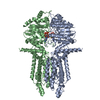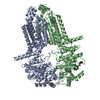+ Open data
Open data
- Basic information
Basic information
| Entry | Database: PDB / ID: 8wbx | ||||||
|---|---|---|---|---|---|---|---|
| Title | Cryo-EM structure of the ABCG25 bound to ABA | ||||||
 Components Components | ABC transporter G family member 25 | ||||||
 Keywords Keywords | MEMBRANE PROTEIN / exporter / complex / transporter | ||||||
| Function / homology |  Function and homology information Function and homology informationintercellular transport / negative regulation of post-embryonic development / abscisic acid transport / export from cell / response to abscisic acid / abscisic acid-activated signaling pathway / efflux transmembrane transporter activity / ATPase-coupled transmembrane transporter activity / ABC-type transporter activity / response to cold ...intercellular transport / negative regulation of post-embryonic development / abscisic acid transport / export from cell / response to abscisic acid / abscisic acid-activated signaling pathway / efflux transmembrane transporter activity / ATPase-coupled transmembrane transporter activity / ABC-type transporter activity / response to cold / transmembrane transport / response to heat / ATP hydrolysis activity / ATP binding / plasma membrane Similarity search - Function | ||||||
| Biological species |  | ||||||
| Method | ELECTRON MICROSCOPY / single particle reconstruction / cryo EM / Resolution: 3.23 Å | ||||||
 Authors Authors | Xin, J. / Yan, K.G. | ||||||
| Funding support |  China, 1items China, 1items
| ||||||
 Citation Citation |  Journal: Plant Commun / Year: 2024 Journal: Plant Commun / Year: 2024Title: Structural insights into AtABCG25, an angiosperm-specific abscisic acid exporter. Authors: Jian Xin / Yeling Zhou / Yichun Qiu / He Geng / Yuzhu Wang / Yi Song / Jiansheng Liang / Kaige Yan /   Abstract: Cellular hormone homeostasis is essential for precise spatial and temporal signaling responses and plant fitness. Abscisic acid (ABA) plays pivotal roles in orchestrating various developmental and ...Cellular hormone homeostasis is essential for precise spatial and temporal signaling responses and plant fitness. Abscisic acid (ABA) plays pivotal roles in orchestrating various developmental and stress responses and confers fitness benefits over ecological and evolutionary timescales in terrestrial plants. Cellular ABA level is regulated by complex processes, including biosynthesis, catabolism, and transport. AtABCG25 is the first ABA exporter identified through genetic screening and affects diverse ABA responses. Resolving the structural basis of ABA export by ABCG25 is critical for further manipulations of ABA homeostasis and plant fitness. We used cryo-electron microscopy to elucidate the structural dynamics of AtABCG25 and successfully characterized different states, including apo AtABCG25, ABA-bound AtABCG25, and ATP-bound AtABCG25 (E232Q). Notably, AtABCG25 forms a homodimer that features a deep, slit-like cavity in the transmembrane domain, and we precisely characterized the critical residues in the cavity where ABA binds. ATP binding triggers closure of the nucleotide-binding domains and conformational transitions in the transmembrane domains. We show that AtABCG25 belongs to a conserved ABCG subfamily that originated during the evolution of angiosperms. This subfamily neofunctionalized to regulate seed germination via the endosperm, in concert with the evolution of this angiosperm-specific, embryo-nourishing tissue. Collectively, these findings provide valuable insights into the intricate substrate recognition and transport mechanisms of the ABA exporter AtABCG25, paving the way for genetic manipulation of ABA homeostasis and plant fitness. | ||||||
| History |
|
- Structure visualization
Structure visualization
| Structure viewer | Molecule:  Molmil Molmil Jmol/JSmol Jmol/JSmol |
|---|
- Downloads & links
Downloads & links
- Download
Download
| PDBx/mmCIF format |  8wbx.cif.gz 8wbx.cif.gz | 196.3 KB | Display |  PDBx/mmCIF format PDBx/mmCIF format |
|---|---|---|---|---|
| PDB format |  pdb8wbx.ent.gz pdb8wbx.ent.gz | 151.2 KB | Display |  PDB format PDB format |
| PDBx/mmJSON format |  8wbx.json.gz 8wbx.json.gz | Tree view |  PDBx/mmJSON format PDBx/mmJSON format | |
| Others |  Other downloads Other downloads |
-Validation report
| Summary document |  8wbx_validation.pdf.gz 8wbx_validation.pdf.gz | 1.3 MB | Display |  wwPDB validaton report wwPDB validaton report |
|---|---|---|---|---|
| Full document |  8wbx_full_validation.pdf.gz 8wbx_full_validation.pdf.gz | 1.3 MB | Display | |
| Data in XML |  8wbx_validation.xml.gz 8wbx_validation.xml.gz | 40.7 KB | Display | |
| Data in CIF |  8wbx_validation.cif.gz 8wbx_validation.cif.gz | 59.7 KB | Display | |
| Arichive directory |  https://data.pdbj.org/pub/pdb/validation_reports/wb/8wbx https://data.pdbj.org/pub/pdb/validation_reports/wb/8wbx ftp://data.pdbj.org/pub/pdb/validation_reports/wb/8wbx ftp://data.pdbj.org/pub/pdb/validation_reports/wb/8wbx | HTTPS FTP |
-Related structure data
| Related structure data |  37426MC  8wamC  8wbaC  8wd6C C: citing same article ( M: map data used to model this data |
|---|---|
| Similar structure data | Similarity search - Function & homology  F&H Search F&H Search |
- Links
Links
- Assembly
Assembly
| Deposited unit | 
|
|---|---|
| 1 |
|
- Components
Components
| #1: Protein | Mass: 77121.148 Da / Num. of mol.: 2 Source method: isolated from a genetically manipulated source Source: (gene. exp.)   #2: Chemical | ChemComp-A8S / ( | Has ligand of interest | Y | |
|---|
-Experimental details
-Experiment
| Experiment | Method: ELECTRON MICROSCOPY |
|---|---|
| EM experiment | Aggregation state: PARTICLE / 3D reconstruction method: single particle reconstruction |
- Sample preparation
Sample preparation
| Component | Name: Homodimer of ABCG25 bound to ABA / Type: COMPLEX / Entity ID: #1 / Source: RECOMBINANT |
|---|---|
| Source (natural) | Organism:  |
| Source (recombinant) | Organism:  |
| Buffer solution | pH: 7 |
| Specimen | Embedding applied: NO / Shadowing applied: NO / Staining applied: NO / Vitrification applied: YES |
| Vitrification | Cryogen name: ETHANE / Humidity: 100 % / Chamber temperature: 281 K |
- Electron microscopy imaging
Electron microscopy imaging
| Experimental equipment |  Model: Titan Krios / Image courtesy: FEI Company |
|---|---|
| Microscopy | Model: FEI TITAN KRIOS |
| Electron gun | Electron source:  FIELD EMISSION GUN / Accelerating voltage: 300 kV / Illumination mode: FLOOD BEAM FIELD EMISSION GUN / Accelerating voltage: 300 kV / Illumination mode: FLOOD BEAM |
| Electron lens | Mode: BRIGHT FIELD / Nominal defocus max: 1800 nm / Nominal defocus min: 800 nm |
| Image recording | Electron dose: 1.5625 e/Å2 / Film or detector model: GATAN K2 SUMMIT (4k x 4k) |
- Processing
Processing
| CTF correction | Type: PHASE FLIPPING ONLY | ||||||||||||||||||||||||
|---|---|---|---|---|---|---|---|---|---|---|---|---|---|---|---|---|---|---|---|---|---|---|---|---|---|
| 3D reconstruction | Resolution: 3.23 Å / Resolution method: FSC 0.143 CUT-OFF / Num. of particles: 53233 / Symmetry type: POINT | ||||||||||||||||||||||||
| Refinement | Cross valid method: NONE Stereochemistry target values: GeoStd + Monomer Library + CDL v1.2 | ||||||||||||||||||||||||
| Displacement parameters | Biso mean: 92.94 Å2 | ||||||||||||||||||||||||
| Refine LS restraints |
|
 Movie
Movie Controller
Controller






 PDBj
PDBj



